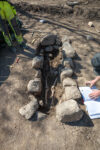 Seven early Christian graves from the Viking Age have been discovered in Sigtuna, southeastern Sweden. They were found in an archaeological survey at the site of a planned residential building on a hill on the western edge of the historic town, and date to the end of the 10th century when the hill was on the outskirts of the town.
Seven early Christian graves from the Viking Age have been discovered in Sigtuna, southeastern Sweden. They were found in an archaeological survey at the site of a planned residential building on a hill on the western edge of the historic town, and date to the end of the 10th century when the hill was on the outskirts of the town.
The seven graves contain the remains of eight individuals as one of them was a double burial of two infants who likely died in or shortly after childbirth. Objects were found in the graves — coins, a comb, a knife, the remains of a belt — typical of pagan funerary practices, but the east-west orientation indicates these were Christian burials. They are markedly different, however, from previous early Christian burials found in Sigtuna. Several of the deceased were placed in wooden coffins that were then buried on a stone-lined bed and covered with more stones. None of the coffins survive, but iron nails attest to their use.
 This tomb design hasn’t been found in the town before, although some have been found in the wider area. Before this discovery, the earliest Christian burials in Sigtuna were spare, simple east-west inhumations with no grave goods. Archaeologists have postulated that there must have been knowledgeable and experienced priests in Sigtuna to ensure a strict adherence to Christian burial practice during what was still a transitional period between belief systems. If so, the recently-unearthed hilltop graves predated their arrival.
This tomb design hasn’t been found in the town before, although some have been found in the wider area. Before this discovery, the earliest Christian burials in Sigtuna were spare, simple east-west inhumations with no grave goods. Archaeologists have postulated that there must have been knowledgeable and experienced priests in Sigtuna to ensure a strict adherence to Christian burial practice during what was still a transitional period between belief systems. If so, the recently-unearthed hilltop graves predated their arrival.
Sigtuna was founded on the banks of Lake Mälaren in the 970s by King Eric the Victorious. It was briefly that capital under the reign of Eric’s son Olof Skötkonung, first Christian king of Sweden. The first Swedish coins were struck by the mint in Sigtuna from the 990s until the early 1030s. Its growth  and prosperity began to decline when the episcopal seat was moved to Old Uppsala around 1164, and the town lost its central economic, political and religious significance to its neighbors.
and prosperity began to decline when the episcopal seat was moved to Old Uppsala around 1164, and the town lost its central economic, political and religious significance to its neighbors.
The bones and grave goods are now being studied and analyzed. Researchers hope to be able to pinpoint the dates of the burials more precisely to shed new light on early Christian burials in Sigtuna. The objects will be conserved for later display at the Sigtuna Museum.
The “Gesta Hammaburgensis” –from 1076AD– mention Sigtuna and Uppsala in IV.26.
Ansgar apparently lived 801–865AD, so I am not entirely sure about the mentioned “King Eric” as Eric the Victorious:
———
Nobilissimum illa gens templum habet, quod Ubsola dicitur, non longe positum ab Sictuna civitate. In hoc templo, quod totum ex auro paratum est, statuas trium deorum veneratur populus, ita ut potentissimus eorum Thor in medio solium habeat triclinio; hinc et inde locum possident Wodan et Fricco. Quorum significationes eiusmodi sunt: Thor, inquiunt, praesidet in aere, qui tonitrus et fulmina, ventos imbresque, serena et fruges gubernat. Alter Wodan, id est furor, bella gerit, hominique ministrat virtutem contra inimicos. Tertius est Fricco, pacem voluptatemque largiens mortalibus. Cuius etiam simulacrum fingunt cum ingenti priapo. Wodanem vero sculpunt armatum, sicut nostri Martem solent; (…) Colunt et deos ex hominibus factos, quos pro ingentibus factis immortalitate donant, sicut in Vita sancti Anscarii leguntur Hericum regem fecisse.
“These folks have a famous temple, known as Uppsala, not far from Sigtuna. In this temple, entirely decked out in gold, the people worship the statues of three gods in such wise that the mightiest of them, Thor, occupies a throne in the middle of the chamber; Wotan and Frikko have places on either side. Their significance is as follows: Thor, they say, presides over the air, which governs the thunder and lightning, the winds and rains, fair weather and crops. The other, Wodan –id est Fury– carries on war and imparts to man strength against his enemies. The third is Frikko, who bestows peace and pleasure on mortals. His likeness, too, they fashion with an immense phallus. Wodan they depict in armor, like they use to do over here with Mars. (…) They also worship deified humans, who they immortalize for their great deeds, like they did according to Vita of St. Ansgar with King Eric.”
———
:hattip:
If you go on the satellite image feature on google maps of Sigtuna (corner of Manfred Björkquist Allé and Sankt Görans gränd) you can see this vacant lot pre-excavation and its circular mounds which I assume indicated the burials. Looks like a nice place to live, at least in the summer.
Thanks, Tristram. The place looks indeed nice (i.e. in summer). The coordinates seem to be 59.614438N, 17.7108515E. Allegedly, the meaning of “Sigtuna” is said to be “contested”, but to me personally it is clearly ‘-tuna’ [or ‘t(h)uin’ (-dunum)], indicating an enclosed stronghold, and “Sigis” as a name (like “Eskil” and nearby Eskilstuna).
A slightly distorted timeline 1000 years ago might be explained as, if there was some kind of “world-wide web”, you in most cases you had to take a boat to use it. After your return you then had to chisel a report, and in some cases it may have taken a while for at least somebody to take notice, as it did with reports that you read abroad.
In 1066/67 Adam was invited by archbishop Adalbert, was accepted among the capitulars of Bremen, and by 1069 he appeared as director of the cathedral’s school. A stay at the court of Svend Estridsen in Denmark gave him the opportunity to find information about the history and geography of Scandinavia.
Yes, it appears that Sigtuna in its day was not your random small town as the post makes clear. If you google “St. Olof church ruins” you will see one of Sweden’s early churches which may have been built over its first church.
It is somewhat sad that the archaeological site will now be turned into a building site. For over 1000 years it was a respected as a place not to be built upon but now that’s out the window.